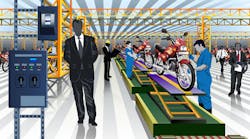How to Position Smart Manufacturing to the C-Suite
Every successful project starts with a champion. Maybe that’s you?
You might be an IT manager, or a process or industrial or electrical engineer. Or the head of operations. You need to know how to make your leadership team see the benefits of Smart Manufacturing the same way you do.
First, think about your drivers
If you’re a mechanical engineer, your primary driver is probably to make the machinery work better. If you’re a process engineer, your driver is optimizing the process.
Regardless, you want to engineer a better solution. Change knobs or dials or timers or temperatures to make things work better.
If you’re in IT, you want sophisticated systems that give you plenty of data to work with. You know you can get better plant performance if you have sophisticated analytical tools.
Now, forget your drivers
Your drivers are your strength and your weakness, in terms of convincing the C-Suite.
Chances are, your leadership team has heard many pitches from engineers who have designed or discovered a way to make X machine run faster. Or who see a crying need for a brand-new Z machine. It’s the nature of your work.
Similarly, they’ve heard the pleas from IT for this or that platform or program or product.
To leadership, all these requests sound similar. At the worst, they may sound like yet another request for another shiny new toy.
So try to forget about your drivers for your pitch on Smart Manufacturing, and focus on their drivers.
What drives the leadership team?
What drives your leadership team? Easy—it’s money! If you don’t link your request/suggestion to soon, realizable and considerable ROI, they won’t be paying attention. While you may care about performance for the sake of performance, they care about payback.
To sway the C-suite, build a business case
You want to go to your leadership with a business case.
Instead of starting with the technology, start with the business opportunity. And the solution.
Say you’re a mechanical engineer and you know your downtime on Line 3 is high. You can back this up, because you’ve compared Line 3’s against industrial standards from sources such as MESA or Gartner.
Another—often the best—source of data is your ERP system. If you’re a process engineer you might start there because most ERP systems know, at a macro level, how much energy, or waste, or raw product you are using. From there, opportunities arise.
Now you can work out how much you would save (or how much more you could produce) if you could decrease downtime by X%, or waste by Y%. Then you can estimate how much it would cost to execute your first Smart Manufacturing project.
Now, you have a business case. Here are a few more tips:
- Start small. Look for easy. Keep it simple.
- Quantify the size of the prize: if I can change this figure from X to Y it will drive the following savings.
- Aim for a reasonably short payback.
The irony here?
The irony here is that this blog isn’t really a Smart Manufacturing story. It’s a sales story. At the end of the day, what we’re doing is defining a vision, a value proposition, and a quick win.
Too often, internal salespeople (aka champions) make the same mistake that external ones do. They focus on the technology, on the how. And neglect the why, which is the ROI, the payback, the hook that catches their listeners’ attention.
Remember to mention in your business case that with Smart Manufacturing, that payback is ongoing. And often, growing.






